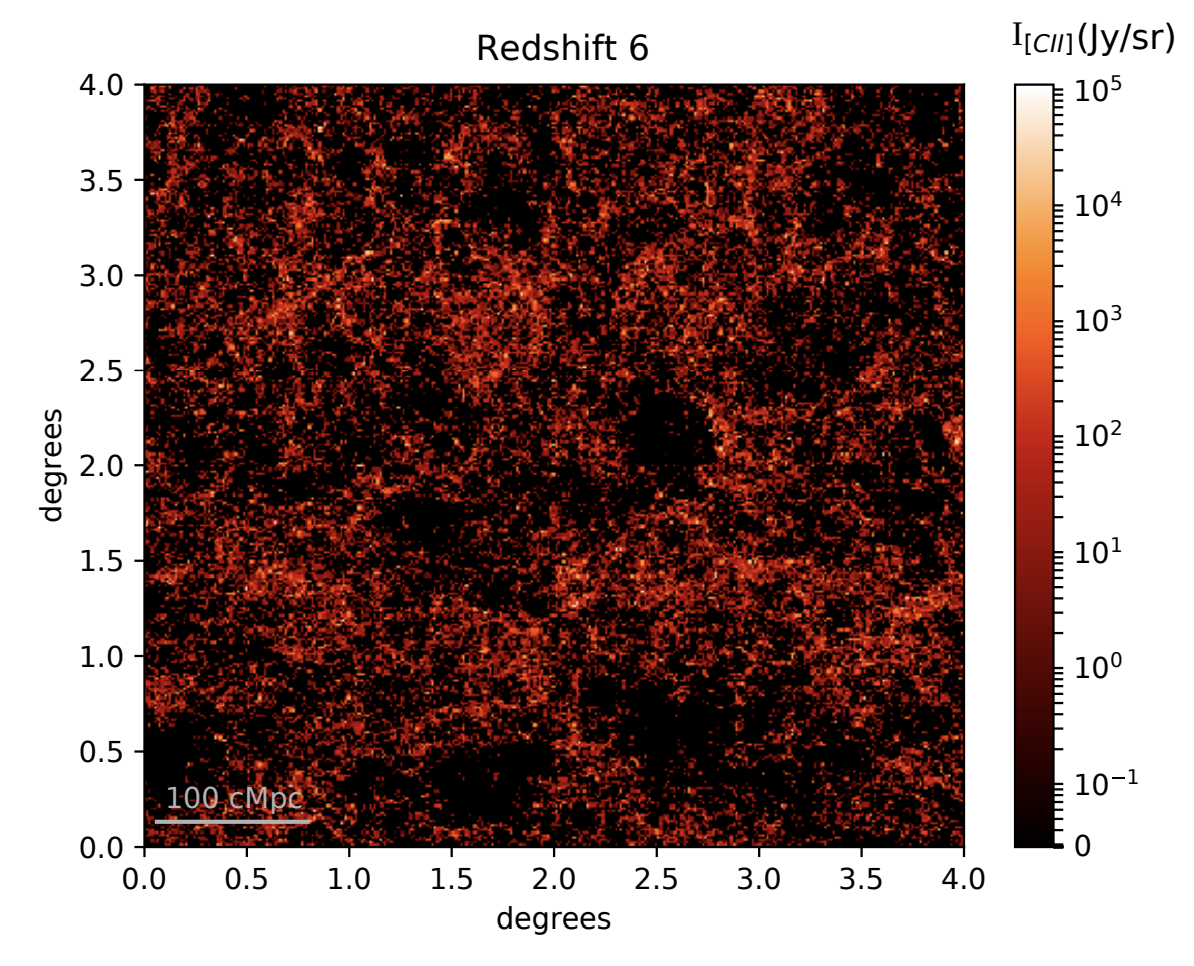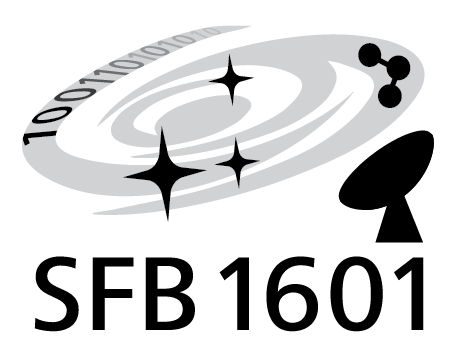Project leaders: Porciani, Cristiano (AIfA); Riechers, Dominik (PH1)

If a line intensity mapping (LIM) measurement is made, what can we infer about the properties and spatial distribution of the underlying population of emitters? The main objective of sub-project C6 is to answer this question by (i) building estimators for different summary statistics that can be extracted from the maps; (ii) generating realistic mock data sets on which to test the estimators; (iii) building a Bayesian toolkit to reconstruct key properties of the underlying galaxy population from the measured data. Direct applications of our findings to the line intensity maps obtained with FYST in sub-project C3 are an integral part of the research done in C6.
2025
Dannhauer, Simon M.; Vider, Sebastian; Schneider, Nicola; Simon, Robert; Comeron, Fernando; Keilmann, Eduard; Walch, Stefanie; Bonne, Lars; Kabanovic, Slawa; Ossenkopf-Okada, Volker; Seifried, Daniel; Csengeri, Timea; Djupvik, Amanda; Gong, Yan; Brunthaler, Andreas; Rugel, Michael; Riechers, Dominik A.; Bontemps, Sylvain; Honingh, Netty; Graf, Urs U.; Tielens, A. G. G. M.
The Diamond Ring in Cygnus X: Advanced stage of an expanding bubble of ionised carbon Journal Article
In: Astronomy & Astrophysics, vol. 703, iss. A197, pp. 14, 2025.
@article{Dannhauer2025,
title = {The Diamond Ring in Cygnus X: Advanced stage of an expanding bubble of ionised carbon},
author = {Simon M. Dannhauer and Sebastian Vider and Nicola Schneider and Robert Simon and Fernando Comeron and Eduard Keilmann and Stefanie Walch and Lars Bonne and Slawa Kabanovic and Volker Ossenkopf-Okada and Daniel Seifried and Timea Csengeri and Amanda Djupvik and Yan Gong and Andreas Brunthaler and Michael Rugel and Dominik A. Riechers and Sylvain Bontemps and Netty Honingh and Urs U. Graf and A. G. G. M. Tielens},
doi = {10.1051/0004-6361/202556159},
year = {2025},
date = {2025-09-01},
urldate = {2025-09-01},
journal = {Astronomy & Astrophysics},
volume = {703},
issue = {A197},
pages = {14},
keywords = {},
pubstate = {published},
tppubtype = {article}
}
Keilmann, E.; Dannhauer, S.; Kabanovic, S.; Schneider, N.; Ossenkopf-Okada, V.; Simon, R.; Bonne, L.; Goldsmith, P. F.; Güsten, R.; Zavagno, A.; Stutzki, J.; Riechers, D.; Röllig, M.; Verbena, J. L.; Tielens, A. G. G. M.
[C II]-deficit caused by self-absorption in an ionized carbon-filled bubble in RCW79 Journal Article
In: A&A, vol. 697, pp. L2, 2025.
@article{2025A&A...697L...2K,
title = {[C II]-deficit caused by self-absorption in an ionized carbon-filled bubble in RCW79},
author = {E. Keilmann and S. Dannhauer and S. Kabanovic and N. Schneider and V. Ossenkopf-Okada and R. Simon and L. Bonne and P. F. Goldsmith and R. Güsten and A. Zavagno and J. Stutzki and D. Riechers and M. Röllig and J. L. Verbena and A. G. G. M. Tielens},
doi = {10.1051/0004-6361/202453445},
year = {2025},
date = {2025-05-01},
urldate = {2025-05-01},
journal = {A&A},
volume = {697},
pages = {L2},
keywords = {},
pubstate = {published},
tppubtype = {article}
}
Riechers, Dominik A.
Do Unusually Cold Starburst Galaxies Exist? A Case Study Journal Article
In: Astrophysical Journal, vol. 980, no. 1, pp. 59, 2025.
@article{2025ApJ...980...59R,
title = {Do Unusually Cold Starburst Galaxies Exist? A Case Study},
author = {Dominik A. Riechers},
doi = {10.3847/1538-4357/ada4ac},
year = {2025},
date = {2025-02-01},
journal = {Astrophysical Journal},
volume = {980},
number = {1},
pages = {59},
keywords = {},
pubstate = {published},
tppubtype = {article}
}
2024
Fichtner, Yvonne A.; Mackey, Jonathan; Grassitelli, Luca; Romano-Díaz, Emilio; Porciani, Cristiano
Connecting stellar and galactic scales: Energetic feedback from stellar wind bubbles to supernova remnants Journal Article
In: A&A, vol. 690, pp. A72, 2024.
@article{2024A&A...690A..72F,
title = {Connecting stellar and galactic scales: Energetic feedback from stellar wind bubbles to supernova remnants},
author = {Yvonne A. Fichtner and Jonathan Mackey and Luca Grassitelli and Emilio Romano-Díaz and Cristiano Porciani},
doi = {10.1051/0004-6361/202449638},
year = {2024},
date = {2024-10-01},
urldate = {2024-10-01},
journal = {A&A},
volume = {690},
pages = {A72},
keywords = {},
pubstate = {published},
tppubtype = {article}
}
Clarke, J.; Karoumpis, C.; Riechers, D.; Magnelli, B.; Okada, Y.; Dev, A.; Nikola, T.; Bertoldi, F.
[CII] luminosity models and large-scale image cubes based on COSMOS 2020 and ALPINE-ALMA [CII] data back to the epoch of reionisation Journal Article
In: A&A, vol. 689, pp. A101, 2024.
@article{2024A&A...689A.101C,
title = {[CII] luminosity models and large-scale image cubes based on COSMOS 2020 and ALPINE-ALMA [CII] data back to the epoch of reionisation},
author = {J. Clarke and C. Karoumpis and D. Riechers and B. Magnelli and Y. Okada and A. Dev and T. Nikola and F. Bertoldi},
doi = {10.1051/0004-6361/202450300},
year = {2024},
date = {2024-09-01},
journal = {A&A},
volume = {689},
pages = {A101},
keywords = {},
pubstate = {published},
tppubtype = {article}
}
References
- Cantalupo and Porciani, “RADAMESH: cosmological radiative transfer for Adaptive Mesh Refinement simulations”, MNRAS 411, 1678 (2011).
- Compostella, Cantalupo, and Porciani, “The imprint of inhomogeneous He II reionization on the H I and He II Ly∂ forest”, MNRAS 435, 3169 (2013).
- Garaldi, Compostella, and Porciani, “The Goldilocks problem of the quasar contribution to reionization”, MNRAS 483, 5301 (2019).
- Karoumpis, Magnelli, Romano-Díaz, Haslbauer, and Bertoldi, “[CII] line intensity mapping the epoch of reionization with the Prime-Cam on FYST. I. Line intensity mapping predictions using the Illustris TNG hydrodynamical simulation”, A&A 659, A12 (2022).
- Magliocchetti and Porciani, “The halo distribution of 2dF galaxies”, MNRAS 346, 186 (2003).
- Oddo, Sefusatti, Porciani, Monaco, and Sánchez, “Toward a robust inference method for the galaxybispectrum: likelihood function and model selection”, JCAP 2020, 056 (2020).
- Pillepich, Porciani, and Matarrese, “The Bispectrum of Redshifted 21 Centimeter Fluctuations from theDark Ages”, ApJ 662, 1 (2007).
- Spina, Porciani, and Schimd, “The HI-halo mass relation at redshift z ∿ 1 from the Minkowski functionals of 21 cm intensity maps”, MNRAS 505, 3492 (2021).
- Stacey, Aravena, Basu, and 35 co-authors including, Bertoldi, Graf, Riechers, and Schilke, “CCAT-Prime: science with an ultra-widefield submillimeter observatory on Cerro Chajnantor”, Society of Photo-Optical Instrumentation Engineers (SPIE) Conference Series 10700, edited by Marshall and Spyromilio, 107001M (2018).
- Tomassetti, Porciani, Romano-Diaz, Ludlow, and Papadopoulos, “Atomic carbon as a powerful tracer of molecular gas in the high-redshift Universe: perspectives for ALMA.”, MNRAS 445, L124 (2014).

